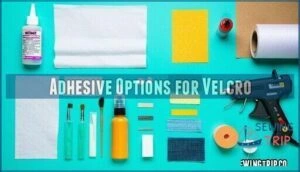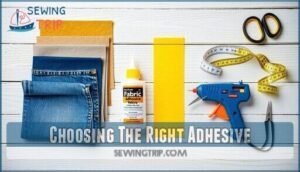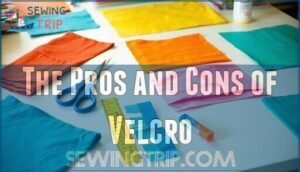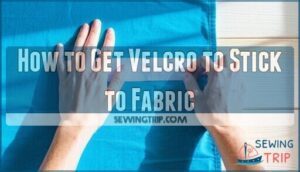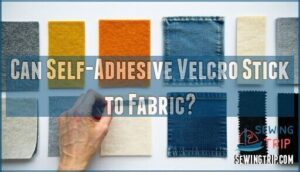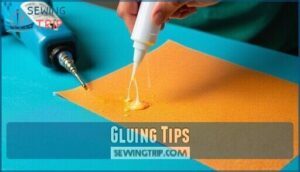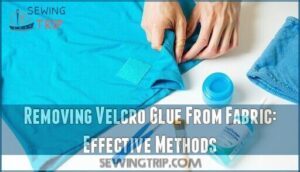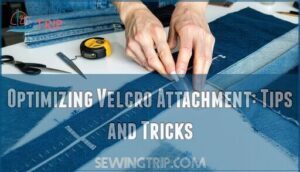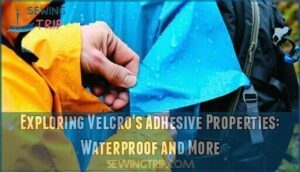This site is supported by our readers. We may earn a commission, at no cost to you, if you purchase through links.
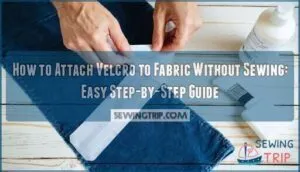 Want to learn how to attach Velcro to fabric without sewing? Start by cleaning the fabric—grit is the enemy of a good bond. Pick your adhesive: fabric glue gives a flexible hold, while self-adhesive Velcro works in a pinch for a quick fix. Press the Velcro down firmly, and let the adhesive cure completely (patience saves you from rogue Velcro later).
Want to learn how to attach Velcro to fabric without sewing? Start by cleaning the fabric—grit is the enemy of a good bond. Pick your adhesive: fabric glue gives a flexible hold, while self-adhesive Velcro works in a pinch for a quick fix. Press the Velcro down firmly, and let the adhesive cure completely (patience saves you from rogue Velcro later).
If you’re aiming for a long-lasting hold, test the glue on a scrap first and reinforce if needed. It’s easier than fighting with a stubborn zipper. Curious how to keep your Velcro sticking like a pro? There’s more just ahead.
Table Of Contents
- Key Takeaways
- Step-by-Step Guide: Attaching Velcro to Fabric Without Sewing
- History and Evolution of Velcro
- The Pros and Cons of Velcro
- Creative Uses for Velcro
- How to Get Velcro to Stick to Fabric
- Can Self-Adhesive Velcro Stick to Fabric?
- Gluing Velcro to Fabric: Step-by-Step Instructions
- Removing Velcro Glue From Fabric: Effective Methods
- Optimizing Velcro Attachment: Tips and Tricks
- Exploring Velcro’s Adhesive Properties: Waterproof and More
- Frequently Asked Questions (FAQs)
- Conclusion
Key Takeaways
- Always clean your fabric thoroughly before attaching Velcro for a solid grip and longer-lasting bond. – Choose an adhesive method—like fabric glue or self-adhesive Velcro—that matches your project and fabric type for best results. – Press the Velcro down firmly and give the adhesive a full 24 hours to cure so it really holds. – Keep in mind that Velcro sticks best to sturdy fabrics like wool and fleece, but might struggle with slick or stretchy materials.
Step-by-Step Guide: Attaching Velcro to Fabric Without Sewing
You don’t need to be a sewing pro to get Velcro to stick—just follow these steps, and you’ll have a secure bond in no time.
Let’s make sure your Velcro stays put, even if your kids or pets have other plans.
Adhesive Options for Velcro
There are several adhesive options you can use for attaching Velcro to fabric—no sewing required! Try fabric glue types for a flexible bond on non-stretchy fabrics. Hot glue works fast but can get messy and stiff, so watch your fingers. Self-adhesive Velcro brings convenience, while iron-on adhesives offer serious staying power for daily-wash items. Spray adhesive tackles large projects, but cover what you don’t want sticky. Each nosew method comes with its own quirks, so focus on durability. No-sew methods are fast and accessible for adhering Velcro.
- Apply a thin, even layer for best results. – Let adhesive cure completely for strong holding. – Clean fabric before sticking. – Test adhesive on a fabric scrap. – Reinforce bond if needed.
Choosing The Right Adhesive
Don’t let your adhesive options turn into a wild goose chase. Choose a glue that matches your fabric type, holds up for your needs, and doesn’t break the bank.
Take a look at the table to see how each option stacks up for adhesive strength, how easy it is to use, and its impact on the environment.
After all, you want your Velcro to keep holding strong—not just hang on for a bit.
History and Evolution of Velcro
After you pick your preferred adhesive option for Attaching Velcro to Fabric, it’s helpful to know a bit about its roots.
The story of Velcro Origins starts with Swiss engineer George de Mestral noticing how burrs stuck to his pants, thanks to their clever hook design—a real “aha” moment! His invention story led to the creation of hook and loop fastener technology.
Thanks to modern adhesive development, Velcro’s history and evolution made it a household staple for no-sew projects everywhere.
The Pros and Cons of Velcro
Adopting no-sew methods for Velcro is like giving your clothes superhero powers—quick, easy, and durable. The Velcro durability means it’ll hold strong through life’s tug-of-wars. However, self-adhesive Velcro sometimes collects lint, losing adhesive strength. Stick to user safety tips, and watch for fabric damage if you ever need to remove Velcro glue. Eco-friendliness? Not its strongest suit, but convenience wins the day.
Here’s a quick checklist:
- Clean surfaces boost Velcro’s stick. – Press firmly for max grip. – Avoid delicate fabrics.
Creative Uses for Velcro
If you’re looking to shake things up in your daily routines, Velcro is your ticket to a bit of DIY magic. You can transform your shed, craft room, or even your pet’s toy basket in minutes. From sorting gardening tools to whipping up fabric art, there’s no shortage of ways to use Velcro Crafting and no-sew methods for velcro. Try self-adhesive Velcro strips, or—if you want extra durability—grab iron-on Velcro for lasting DIY accessories.
- Hang gardening tools with ease. – Whip up quick fabric collages. – Attach cleaning cloths for easy swaps. – Give pet toys a fresh twist. – Reinforce loose shoes with zero sewing.
How to Get Velcro to Stick to Fabric
Take charge of your projects with solid Velcro adhesion—there’s only one way to win: get the details right from the start.
- Always prep your fabric by washing and drying it for the best bond strength. Stick with adhesive options for Velcro that match the fabric type for lasting results.
For nosew methods, press down firmly when attaching Velcro to fabric, making sure every fuzzy bit gets to know the sticky side. Give it time—don’t rush the adhesive application!
Can Self-Adhesive Velcro Stick to Fabric?
You can use self-adhesive Velcro on fabric, but it’s not magic—adhesive strength drops on certain fabric types. For best results, clean the area before applying, then press firmly. Lightweight cotton and felt hold up better than heavy or slick surfaces.
If you want more staying power, explore no-sew methods or other Velcro alternatives for attaching Velcro to fabric. The effectiveness of Velcro also depends on the hook and loop system, which is essential for a strong bond.
Gluing Velcro to Fabric: Step-by-Step Instructions
If you’d rather skip the sewing but still want a solid hold, gluing Velcro to fabric is a great trick that’s easier than you might think.
Roll up your sleeves and get ready to stick those strips on tight, with a few helpful steps to keep things sticking for good.
Application Technique
Getting ready to attach Velcro is simple if you follow these steps. Start with good surface prep: wash and dry your fabric—no shortcuts.
Cut the Velcro, leaving extra for overlap. Using hands or simple attachment tools, stick the strip down, starting at the center for even pressure. Don’t rush—adhesive strength takes time.
Let it set for at least 24 hours. Avoid wearing or washing right away; good bonding methods need patience. Nosew methods for Velcro can feel like magic—if you let the glue work!
Gluing Tips
After you’ve laid out the Velcro and double-checked your surface prep, start gluing with focus—think of glue as maple syrup: a little goes a long way, and you don’t want sticky puddles everywhere. Choose your glue types carefully. Hot glue gives quick results, fabric glue offers bond strength for frequent use, and removable adhesive is handy when you might change your mind.
Easy wins:
- Leave a seam allowance around the Velcro’s edge to avoid glue spillage. – Let the adhesive set—rushing dries out the results and weakens the bond. – If you want super secure, reinforce with a few stitches for extra muscle.
Removing Velcro Glue From Fabric: Effective Methods
Got some tough Velcro glue stuck on your favorite fabric? Don’t stress—it’s actually pretty easy to get it off for good.
These easy tips will help you tackle sticky messes and keep your fabric looking its best, even after a Velcro mishap.
Citrus Adhesive Remover
For stubborn glue, a citrus adhesive remover comes to the rescue—just make sure you’re not dousing your favorite shirt. Here’s how to master this nosew method for velcro:
- Spot test a hidden area first
- Dab Citrus Cleaner with a cotton swab
- Wait 5-10 minutes
- Rub gently with a cloth
- Repeat as needed
Sticky problem solved!
Freezing Method
If citrus cleaners aren’t your thing, try the Frost Method—pop your fabric in the freezer for an hour. The glue gets brittle, making Freezer Removal a breeze.
Gently use a dull knife to “Ice Peel” off the residue. This Cold Bonding trick keeps fibers safe, prepping your fabric for strong Adhesive Strength and a fresh nosew method.
Acetone Method
If glue is holding on for dear life, grab some acetone. Dip a cotton swab, dab gently at the stubborn spot, and watch the glue loosen its grip. Acetone dries fast, doesn’t stink up the place, and is safe for most fabrics.
Remember:
- Always test a small area. – Keep the room well-ventilated. – Use gloves for acetone safety.
Stain Removal Tips
Before you reach for any adhesive remover, always spot test it on a hidden corner of your fabric. Stain prevention starts with patience—don’t rush the process.
If the glue residue gives you trouble, try these:
- Let adhesive cleanup agents soak for a few minutes. – Gently blot, don’t scrub, to protect fabric restoration and avoid extra stains.
Acceptance of Stains
Sometimes, no matter what you try, that glue stain just won’t come out. Instead of giving up on the fabric, here are a few ways to make the best of those stubborn spots:
- Cover stains with a bright patch or funky fabric dye. – Rock the stains as a sign of adventure.
- Choose color-fast, stain-resistant fabric next time. – Prioritize adhesive durability and prep before cleaning.
Optimizing Velcro Attachment: Tips and Tricks
Getting Velcro to stick can feel like a mystery, but a few simple tricks will make your project stick strong and last longer.
If you follow these tips, you won’t find your Velcro coming loose the first time you grab your bag or jacket.
Fabric Compatibility
Some fabrics are just better for attaching Velcro without sewing—think fleece, wool, or sturdy knits. These help boost adhesive strength and make no-sew methods super reliable.
Always test material first, since prepping the surface helps the bond last. Not sure if your fabric is Velcro-friendly? Start here:
| Fabric Type | Velcro Compatibility |
|---|---|
| Wool, Fleece | Excellent |
| Smooth Nylon | Fair |
| Stretch Fabrics | Poor |
Hook and Loop Placement
Now that you’ve picked the right fabric, it’s time to master Velcro alignment. For better grip, place the hook side where you need the strongest hold, usually on static surfaces. The loop side sits on the moveable piece.
Keep these tips in mind:
- Space fasteners evenly
- Match loop direction
- Use clear attachment patterns
- Press firmly for best results
Troubleshooting Weak Bonds
If your Velcro starts slipping, don’t lose your grip—there’s a fix. Check these quick troubleshooting tips for a stronger, longer-lasting bond:
- Clean the fasteners with a little soap and water. – Upgrade your adhesive selection or double up with reinforcement methods. – Replace stubborn strips and start fresh, making sure your surface preparation, pressure application, and curing time are spot on.
Velcro Maintenance
Once you’ve tackled weak Velcro bonds, it’s time for Velcro cleaning and hook maintenance. Gently brush lint away, check for glue residue, and handle stain removal with a citrus adhesive remover if needed.
For loop replacement or torn patches, reapply adhesive. Use simple storage solutions—keep things dry, flat, and clean. Small steps go a long way toward Velcro longevity!
Exploring Velcro’s Adhesive Properties: Waterproof and More
Sometimes life throws a rainy day or a scorcher your way—that’s when you want Velcro adhesives that laugh in the face of chaos. With waterproof adhesives, temperature resistance, and reliable bond strength, you’re set for everything from swimwear to snow gear.
Here’s why folks swear by these adhesive options for Velcro:
- Water won’t rinse away your hard work. – Heat or cold won’t weaken the hold. – Heavy loads? No problem for durable, long-lasting, self-adhesive Velcro.
Stick with what works—no sewing required!
Frequently Asked Questions (FAQs)
How do I get Velcro to stick without sewing?
Trying to stick Velcro can feel like wrestling a stubborn octopus.
Prep your fabric, use fabric glue or self-adhesive strips, press firmly, and let it dry overnight. That extra patience gives you a bond that actually holds.
Can you attach Velcro to fabric without sewing?
If you want a shortcut to keep things moving, grab adhesive-backed Velcro or fabric glue.
Press both parts together, hold tight, and let them set. It’s like magic—no need for needles, just stick and go!
How do you attach Velcro to fabric?
Wrestling with sticky Velcro is almost a rite of passage! Cut your strips, eyeball the perfect spot, clean the fabric, and press hard—like you mean business.
Let it cure, and you’ll enjoy a bond that lasts.
Does Velcro stick to fabric?
Velcro will stick to most fabrics—wool, fleece, and felt love it. But for velvet or anything silky smooth, you’ll hit a snag.
Clean your fabric first and press firmly—your future self will thank you!
Can You glue Velcro to fabric?
Stick with glue and skip the sewing marathon—fabric glue bonds Velcro like peanut butter and jelly.
Clean the fabric, dab on the glue, press firm, and let it dry. That’s a strong, easy fix!
How long does Velcro take to attach?
Expect to wait at least 24 hours for a secure bond. Don’t rush it or you’ll end up chasing runaway patches.
Press firmly, let it sit, and you’ll have a grip strong enough to survive laundry day.
What are some creative uses for Velcro beyond clothing and shoes?
Imagine your garage as a cluttered jungle—Velcro turns chaos to order. Use it to hang tools, organize cables, or keep remotes handy.
Label bins, secure gardening gloves, or attach cleaning pads—simple, quick, and effective.
How can I get Velcro to stick to fabric more effectively?
Start by giving that fabric a good cleaning—dust and oils are Velcro’s arch-nemesis. Press adhesive Velcro down hard, then let it cure overnight.
For stubborn projects, reinforce with fabric glue. Patience now prevents headaches later!
What are the pros and cons of using Velcro as a fastening method?
You get quick open-and-close access and a flexible fit, but sometimes, Velcro grabs lint like a magnet and can lose grip after many washes.
It’s great for fast fixes—just don’t expect a forever hold.
How long does Velcro adhesive typically last?
Like a trusty pair of old sneakers, Velcro adhesive usually sticks around for about one to two years if you keep things clean and dry.
For best results, always press it firmly and avoid frequent washing.
Conclusion
Fast fixes and firm finishes—that’s the secret to mastering how to attach Velcro to fabric without sewing. Tidy up your workspace, stick with the right glue, and don’t skimp on pressing the Velcro down well.
Waiting for the adhesive to fully set can feel like forever, but you’ll thank yourself later. Try different Velcro types until you find what sticks best for your project. Now you’re set for strong, reliable bonds and zero sewing stress!
- https://www.custompatchfactory.com/guides/how-to-add-velcro-to-a-patch-fabric-without-sewing
- https://www.tramigosourcing.com/news/which-adhesive-works-best-for-sticky-velcro-strips-in-2025/
- https://verycreate.com/best-glue-for-velcro-to-fabric/
- https://www.hookandloop.com/blog/which-adhesive-should-i-use-for-my-hook-and-loop
- https://www.mpdhookandloop.com/heavy-duty-or-acrylic-tape-your-adhesive-velcro-brand-guide/

